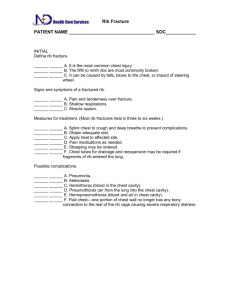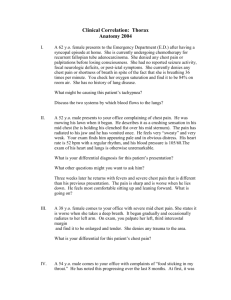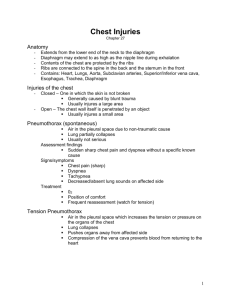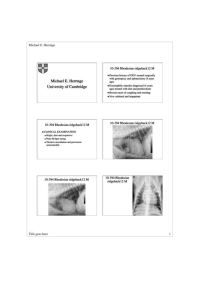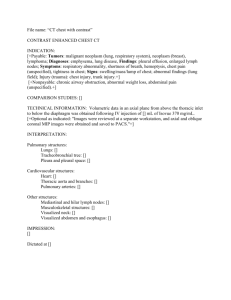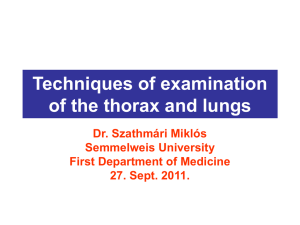Pectus excavatum
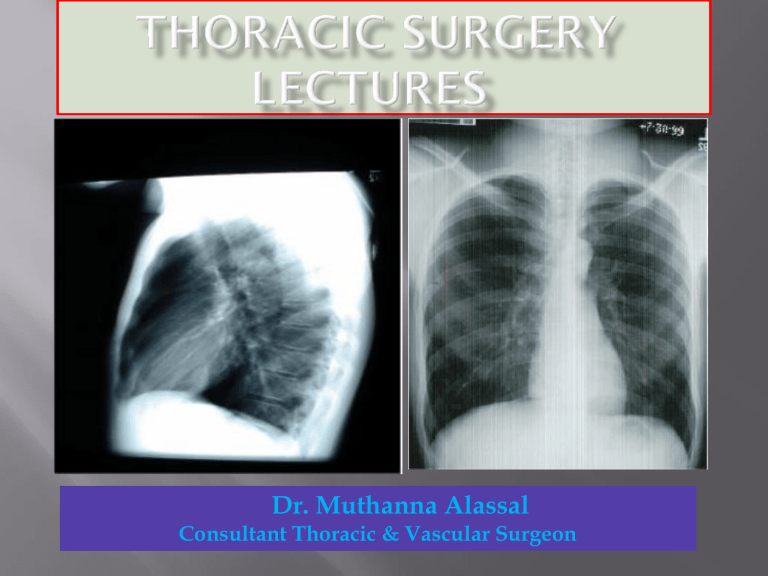
Dr. Muthanna Alassal
Consultant Thoracic & Vascular Surgeon
Costo –phrenic angle is the angle between the costal &diaphragmatic pleura.
Cardio –phrenic angle is the angle between the heart &diaphragmatic pleura
Inferior pulmonary ligament is the anterior & posterior reflection of the pleura between the root of the lung & the diaphragmatic surface
The function of the pleura is to maintain the environment of the pleural space in which the lung is function.
1-Cough
2-Dyspnea or breathlessness , it is an unpleasant subjective awareness of the sensation of breathing .
3-Chest pain in diseases with pleural or chest wall involvement .
4-Haemoptysis .
Investigations :-
1-Chest X-Ray
2-CT chest
3-MRI mediastinum
4-US chest to detect any effusion .
5-Pleural aspiration .
6-Bronchoscopy flexible or rigid .
1-Tidal Volume (TV)
Is the amount of air inspired or expired per single breath .
2-Functional residual Capacity (FRC)
The amount of gas contained in the lung at the end of quiet expiration .
3-Inspiratory reserve volume;-
Is reached when the patient makes a maximum inspiration and increased the lung volume ,compared with that contained at the peak tidal volume.
4-Vital capacity :-
The volume expired from maximal inspiration to maximal expiration.
5-residual volume :-
Is the amount of air remaining in the lung after maximal expiration.
6-FEV1
Is the volume of air expired in one second .
Dr. Muthanna Al-assal
Thoracic & Cardiovascular Surgeon
Aljirahat hospital /Medical City
Lecturer at Alkindy medical school
Baghdad Unv.
Congenital abnormalities are often incidental findings of
CXR (bifid rib) but there are some important exceptions.
The Cervical rib . This rib is often a fibrous band originating from the seventh cervical vertebra and inserting onto the first thoracic rib.
It may be asymptomatic but because the axillary artery and brachial course over it a variety of symptoms may occur. lower trunk of the plexus (mainly T1) is cornd leading to wasting of the interossei and altered sensation in the T1 distribution.
Compression of the axillary artery may result in a poststenotic dilatation.
with thrombus and embolus formation. Treatment is by division or removal of the rib by a supraclavicular,posterior or axillary approach.
Pectus excavatum .
Pectus carinatum (pigeon chest).
Pectus excavatum
Is the most common congenital deformity of the anterior wall of the chest, in which several ribs and the sternum grow abnormally. This produces a caved-in or sunken appearance of the chest. It is
.
usually present at birth and progresses during the time of rapid bone growth in the early teenage years, but in rare cases does not appear until the onset of puberty
Pectus excavatum is sometimes considered to be cosmetic, however it can impair cardiac and respiratory function, and cause pain in the chest and back. People with the abnormality may experience negative psychosocial effects, and
.
avoid activities that expose the chest
Signs and symptoms
The hallmark of the condition is a
.
sunken appearance of the sternum
.
Base lung capacity is decreased -
-
.
( The heart is displaced (and rotated -
.
Mitral valve prolapse may also be present -
Treatment
.
detimil si hcihw : Medical treatment
eb dluohs stset lareves noitarepo erofeB
: edulcni esehT .demrofrep
: Surgery
.
CT scan -
.
Pulmonary function tests -
.
Cardiology exams (such as auscultation ECGs, and Echocardiography)
-
, Sx=Ravitch op.(sternal turn over)
& , correction osteotomy
.
Nuss procedure
Less common.
It consist of protrusion of the sternum caused by an upward curve in the lower costal cartilages.
Generally the 4th to 8th cartilages pushing the sternum forward….
Surgery is the treatment of choice in the symptomatic patients.
These can be tumours of any component of the chest wall, i.e. bone, cartilage and soft tissue.
The most common tumour is that of the rib ( chondroma or osteoma ) and presentation is as a hard swelling over the rib.
Malignant tumours are painful end destructive and require wide resection. Even so, there is a tendency for tumours to recur and histological classification is difficult.
Tumours of the sternum are usually malignant.
Lung and pleural tumours may involve ribs and destroy them.
Most lesions may be seen on a chest radiograph but occasionally CTscan or isotope bone scanning is required.
Excision biopsy is often the best way to deal with a rib neoplasm because the differentiation between benign and malignant growths may be difficult. This avoids the risk of
‘spillage’ and tumour seeding in the wound of an incision biopsy.
If a major resection is to be planned, it may be
preferable to know the nature of the lesion before surgery .
The principle of surgery is to remove the rib along with the rib immediately above and below, and for a length
well from the margins of the tumour.
Reconstruction is possible using a prosthetic material
(Marlex or acrylic mesh ) to provide some stability to the chest wall. Myocutaneous flaps are occasionally employed to more extensive tissue defects and therefore prior ;discussion with a plastic and reconstructive surgeon may be useful.
For lesions that are not amenable to resection,
chemotherapy or radiotherapy , although unlikely to be curative, may provide symptomatic relief.
Infections of the chest wall
These are unusual but may occur following osteomyelitis of the underlying rib.
An empyema of the underlying thoracic cavity may discharge through the chest wall ( empyema necessitans ) leaving a chronic sinus.
Sterile pus should arouse the clinician that tuberculosis is present.
Treatment of the chest wall infection depends on adequate treatment of the underlying condition
THANK YOU
1 -Spontaneous pneumothorax
Is the accumulation of air inside the pleural cavity , occurring without any known etiology .More in males ,more on the right side .It can be bilateral
Causes
1- Ruptured pulmonary bleb.
2-Ruptured of a cystic defect in the pleura.
3-Teared visceral pleura
4-No cause can be demonstrated in (15-20%).
Complications:-
1-pleural effusion
2-empyema
3-tension pneumothorax which leads to mediastinal shift &circulatory collapse.
4-Respiratory failure in elderly patient with COAD .
Treatment :-
1-Bed rest ,O2 administration &observation in limited pneumothorax.
2-Aspiration
3-Chest tube (thoracostomy tube or ICD intercostal drain in a safety triangle which is bounded by pectoralis muscle anteriorly &lattismus muscle posteriorly and the superior border of the nipple.in the fifth intercostal space just anterior to the mid axillary line to avoid the long thoracic nerve .
4-bronchoscopy is indicated if the lung fail to expand
5-Chemical pleurodesis.by injecting sclerosing agent as Tetra cycline
6-Surgery pleurectomy by thoracotomy or thoracoscopically if the lung fail to re expand
2-Spontaneous haemothorax
Is the presence of blood inside the pleural cavity
Causes:-
1-pulmonary causes ----------TB , AV malformation
2-pleural causes -----------torn vascular adhesion
3-pulmonary malignancy ….primary or metastatic
4-blood dyscrasia ……………..hemophilia
5-abdominal pathology ……….. haemo peritoneum
6-thoracic causes ………ruptured great vessels
Clinical features dyspnea , chest pain ,syncope signs of hypovolaemic shock blood inside the pleural cavity may leads to deposition of fibrin on the pleural surface leading to fibrosis ( trapped lung syndrome) .
Treatment
1-Resuscitation
2-Tube thoracostomy
3-May needs thoracotomy if excessive bleeding initial bleeding more than 1.5 liter
Or continuous bleeding more than 200 ml/hour for more than 4 hours
•
